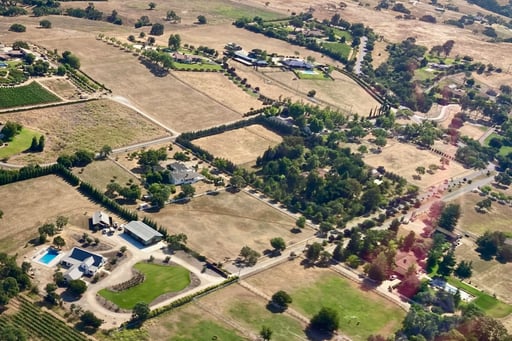"Sweat and surplus": the writing of a profile story
I had the great opportunity of talking with Gregg this past summer. His story was so unique that I turned it into a profile article. Here it is, with some 'how to' tips.
HC CREATIVE
3/11/20244 min read
Gregg's story was one of having a vision for a safer community and not taking 'no' for an answer. I love learning how someone takes an idea and makes it happen. Of course, when I first started talking to him, I didn't know this about Gregg yet. How did I discover the golden nuggets of his tale? My tips:
Get general knowledge before the interview. I researched where he'd worked; this helped me 'fill in the blanks' as Gregg talked, such as when he used the local term 'Vandenburg' about the nearby air force base.
Guide but don't direct. I knew I wanted to hear about his career in helicopters but when the conversation turned to his personal flying, I learned something entirely new that I never expected.
Go over the interview three days later. I finished our interview and let it percolate in my brain for a few days. When I thought back to it, the parts I remembered most were what I built the story around. Here's the result. Happy reading!
Sweat and surplus: how to build a helicopter unit from scratch
If Los Angeles is known for theatricality, Santa Barbara County could well be defined by its individualism. People here make their homes in house boats and sprawling ranches. Summertime could see a Pride event threading through Solvang as a rodeo kicks up dust in Santa Ynez. The landscape itself seems to go in for attention-grabbing. Mountain peaks reach 6,800 feet, and part of the county lies in the Pacific Ocean — 30 miles offshore are the Channel Islands.
COP, FIREFIGHTER, MEDIC
Fierce independence mixed with an outdoor lifestyle and 2,744 square miles of varied terrain — with the fun comes a fair-sized workload for the Santa Barbara County Air Support Unit (ASU), a joint Sheriff and Fire Department that operates a Cessna fixed-wing and five Bell and Sikorsky helicopters.
The ASU's purview includes law enforcement, search and rescue, fire suppression and medical response for an area of city and country, mountain and water. A February 2018 Facebook post from the Santa Barbara County Sheriff's office notes in one 24-hour period the ASU responded to the search and rescue of a hiker who had fallen into a canyon; the airlift of an injured oil worker; the pursuit of a burglary suspect in a stolen vehicle; and the medical transport of a rider thrown from a horse. That the Air Support Unit could respond to all, without help from a neighboring unit, is a typically individual story that dates back 40 years.
AN IDEA BORN FROM NEED
In 1984, Gregg Weitzman was a young deputy on the Santa Barbara police force. Observing the department's reliance on other agencies when it came to aircraft, just before leaving for army flight training he broached the subject of starting an aviation wing with his sheriff at the time. His request was turned down. "I was only 21 and I didn't really know my options," says Weitzman, relaxing outdoors on a late summer day. "Instead, I set out to make myself the best helicopter pilot possible."
"I set out to make myself the best helicopter pilot possible."
So Weitzman saved up, put his personal life on hold and flew helicopters. On his days off, he did traffic reporting from a Bell Jet Ranger in L.A. just to gain experience. His career evolved, from deputy to diver, then the Transportation Unit and Special Enforcement Team and eventually, coordinator of the all-volunteer Aero Squadron.
EYES FIXED ON THE GOAL
"At the same time, I was already writing and researching and putting everything into words on how to get a helicopter program. I spent eight years writing all the manuals, writing grants and learning," says Weitzman.
He traveled across the country and flew with some 25 different police aviation units, noting how they trained, whom and where they recruited, how dispatching worked. With the support of a new sheriff and access to the 1208 Department of Defense military surplus program (LESO), Weitzman soon took charge of four Army surplus Bell OH58 airframes. Funding from drug seizure money and Sheriff's Council fundraising financed the rebuild of two complete helicopters using parts from the four originals. And then in 1997, "we started up a patrol," he says.
"JUST GETTING GOING"
Immediately, a high-profile case showed what the unit was capable of. While flying patrol, Weitzman (the ASU's first helicopter pilot) and his co-pilot located and pursued four prison escapees suspected in the robbing of a credit union which resulted in a murder. "The sheriff said, 'you guys just locked this program in'. And we were still just getting going," says Weitzman.
Pursued four prison escapees suspected in a robbery
Rescues followed and the needs of the county expanded, and Weitzman's team determined they needed a larger aircraft that could handle a hoist. Another bout of fundraising bought the unit a Bell UH-1 Super Huey which, through close to a decade of reconditioning, went into service as a firefighting, medevac and rescue asset. The ASU now numbers a much larger fleet and its crews - who draw on a rigorous background of experience - have assisted at countless incidents over the years, including notable wildfires like the Lake Fire this past July.
Gregg Weitzman retired from the sheriff's department in 2018, the same year heavy mudslides carried away parts of Montecito. The ASU was there to respond.


Santa Barbara County from above, June 2024




